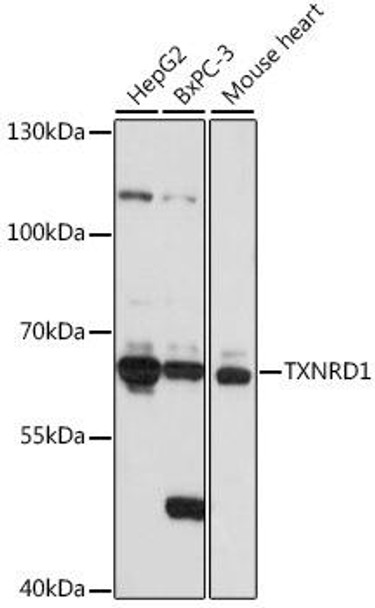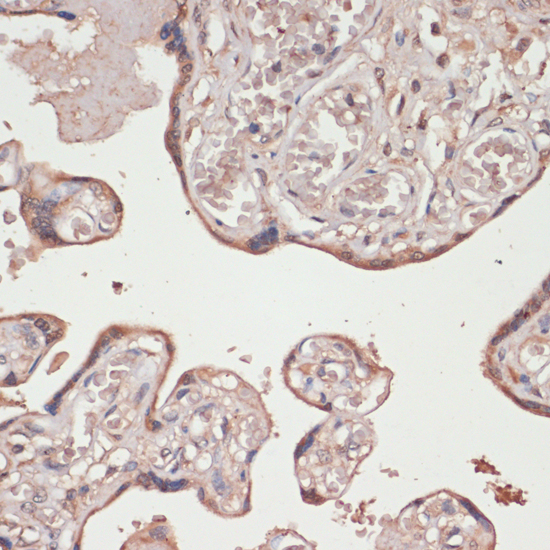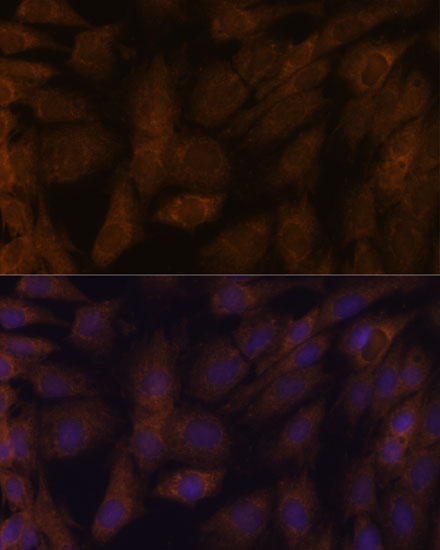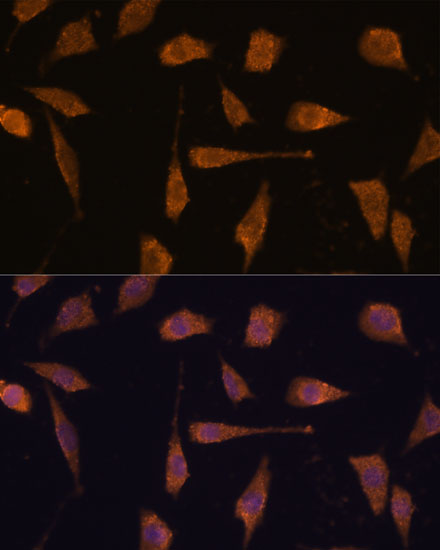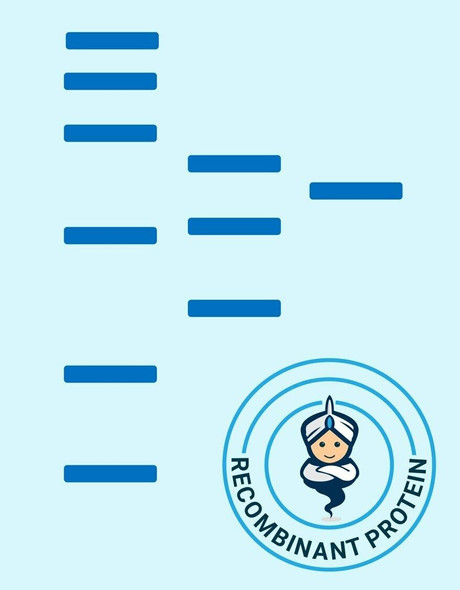Anti-TXNRD1 Antibody (CAB16631)
- SKU:
- CAB16631
- Product type:
- Antibody
- Reactivity:
- Human
- Mouse
- Rat
- Host Species:
- Rabbit
- Isotype:
- IgG
- Antibody Type:
- Polyclonal Antibody
- Research Area:
- Cell Biology
Frequently bought together:
Description
| Antibody Name: | Anti-TXNRD1 Antibody |
| Antibody SKU: | CAB16631 |
| Antibody Size: | 20uL, 50uL, 100uL |
| Application: | WB IHC IF |
| Reactivity: | Human, Mouse, Rat |
| Host Species: | Rabbit |
| Immunogen: | Recombinant protein of human TXNRD1 |
| Application: | WB IHC IF |
| Recommended Dilution: | WB 1:500 - 1:2000 IHC 1:50 - 1:100 IF 1:50 - 1:200 |
| Reactivity: | Human, Mouse, Rat |
| Positive Samples: | HepG2, BxPC-3, Mouse heart |
| Immunogen: | Recombinant protein of human TXNRD1 |
| Purification Method: | Affinity purification |
| Storage Buffer: | Store at -20°C. Avoid freeze / thaw cycles. Buffer: PBS with 0.02% sodium azide, 50% glycerol, pH7.3. |
| Isotype: | IgG |
| Sequence: | Email for sequence |
| Gene ID: | 7296 |
| Uniprot: | Q16881 |
| Cellular Location: | |
| Calculated MW: | 50kDa/54kDa/59kDa/60kDa/65kDa/67kDa/70kDa |
| Observed MW: | 65kDa |
| Synonyms: | TXNRD1, GRIM-12, TR, TR1, TRXR1, TXNR |
| Background: | This gene encodes a member of the family of pyridine nucleotide oxidoreductases. This protein reduces thioredoxins as well as other substrates, and plays a role in selenium metabolism and protection against oxidative stress. The functional enzyme is thought to be a homodimer which uses FAD as a cofactor. Each subunit contains a selenocysteine (Sec) residue which is required for catalytic activity. The selenocysteine is encoded by the UGA codon that normally signals translation termination. The 3' UTR of selenocysteine-containing genes have a common stem-loop structure, the sec insertion sequence (SECIS), that is necessary for the recognition of UGA as a Sec codon rather than as a stop signal. Alternative splicing results in several transcript variants encoding the same or different isoforms. |
| UniProt Protein Function: | TRXR1: a cytoplasmic pyridine nucleotide oxidoreductases. This protein reduces thioredoxins as well as other substrates, and plays a role in selenium metabolism and protection against oxidative stress. The functional enzyme is thought to be a homodimer which uses FAD as a cofactor. Each subunit contains a selenocysteine residue which is required for the catalytic activity. |
| UniProt Protein Details: | Protein type:EC 1.8.1.9; Nuclear receptor co-regulator; Oxidoreductase; Nucleotide Metabolism - pyrimidine Chromosomal Location of Human Ortholog: 12q23-q24.1 Cellular Component: nucleoplasm; nucleolus; cytosol Molecular Function:protein binding; thioredoxin-disulfide reductase activity; FAD binding; electron carrier activity; protein disulfide oxidoreductase activity Biological Process: response to reactive oxygen species; cell redox homeostasis; nucleobase, nucleoside and nucleotide metabolic process; nucleobase, nucleoside and nucleotide interconversion; cellular lipid metabolic process; signal transduction |
| NCBI Summary: | This gene encodes a member of the family of pyridine nucleotide oxidoreductases. This protein reduces thioredoxins as well as other substrates, and plays a role in selenium metabolism and protection against oxidative stress. The functional enzyme is thought to be a homodimer which uses FAD as a cofactor. Each subunit contains a selenocysteine (Sec) residue which is required for catalytic activity. The selenocysteine is encoded by the UGA codon that normally signals translation termination. The 3' UTR of selenocysteine-containing genes have a common stem-loop structure, the sec insertion sequence (SECIS), that is necessary for the recognition of UGA as a Sec codon rather than as a stop signal. Alternative splicing results in several transcript variants encoding the same or different isoforms. [provided by RefSeq, Jul 2008] |
| UniProt Code: | Q16881 |
| NCBI GenInfo Identifier: | 172046253 |
| NCBI Gene ID: | 7296 |
| NCBI Accession: | Q16881.3 |
| UniProt Secondary Accession: | Q16881,Q6FI31, Q6VB40, Q6VB41, Q6VB42, Q6VBP2, Q6VBP3 B7Z1F4, B7Z3Y8, B7Z904, E9PMY9, F5H780, |
| UniProt Related Accession: | Q16881 |
| Molecular Weight: | 50,873 Da |
| NCBI Full Name: | Thioredoxin reductase 1, cytoplasmic |
| NCBI Synonym Full Names: | thioredoxin reductase 1 |
| NCBI Official Symbol: | TXNRD1 |
| NCBI Official Synonym Symbols: | TR; TR1; TXNR; TRXR1; GRIM-12 |
| NCBI Protein Information: | thioredoxin reductase 1, cytoplasmic; oxidoreductase; thioredoxin reductase TR1; thioredoxin reductase GRIM-12; KM-102-derived reductase-like factor; gene associated with retinoic and IFN-induced mortality 12 protein; gene associated with retinoic and interferon-induced mortality 12 protein |
| UniProt Protein Name: | Thioredoxin reductase 1, cytoplasmic |
| UniProt Synonym Protein Names: | Gene associated with retinoic and interferon-induced mortality 12 protein; GRIM-12; Gene associated with retinoic and IFN-induced mortality 12 protein; KM-102-derived reductase-like factor; Thioredoxin reductase TR1 |
| Protein Family: | Tropinone reductase |
| UniProt Gene Name: | TXNRD1 |
| UniProt Entry Name: | TRXR1_HUMAN |

